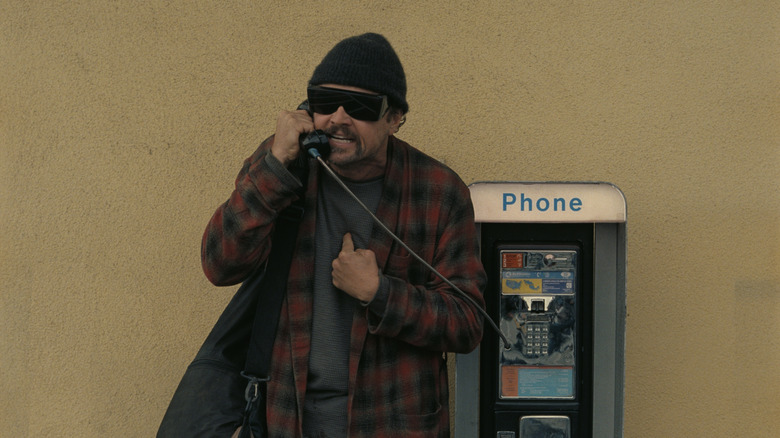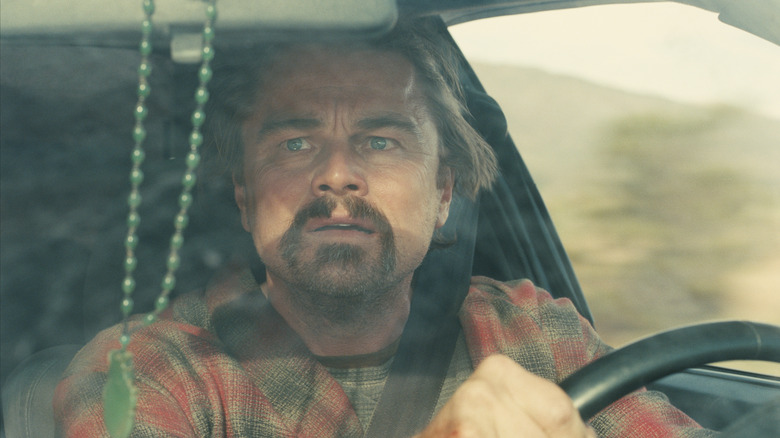One Battle After Another Director Paul Thomas Anderson Broke A Big Rule For One Shot
Spoilers for "One Battle After Another" follow.
Whether it's a romantic comedy like "Punch-Drunk Love" or an epic like "There Will Be Blood," writer/director Paul Thomas Anderson always brings a distinctive visual language to his films. Long takes, moving camera shots, clashes of symmetry and asymmetry, and distinctive color choices often define his work — a combination that often invokes an older era of Hollywood. Despite being known for that strong visual style, Anderson says that his approach is often to let the story and the filming locations determine the shots he takes, rather than going out of his way to create moments of high visual drama.
According to Anderson himself, this rule was central to the production of "One Battle After Another," his latest comedy action-adventure revolutionary epic (say that five times fast). At a screening and talk attended by /Film at New York's Regal Union Square, Anderson discussed his desire to simply "tell the story" without unnecessary visual embellishment.
"Don't get gourmet, don't get too fussy," Anderson said, explaining his philosophy when crafting the visual language of the film. "Make the shots that tell the story, because there's so much story to tell. There's no room for decorations on top or powdered sugar on it, it has to be very economical." In a nearly three-hour movie like "One Battle After Another," with so many set pieces and moving parts, that sort of approach makes sense. However, Anderson did indulge in a bit more of a "gourmet" approach to one specific moment — the confrontation between Willa (Chase Infiniti) and Colonel Lockjaw (Sean Penn) in the chapel at the Sisters of the Brave Beaver mission.
One Battle After Another went old-school Hollywood for the church scene
If you've seen "One Battle After Another," you're probably already picturing the shot in question. After Lockjaw and his cronies attack the mission, his men bring Willa into the chapel, where her soon-to-be-revealed father is waiting. The establishing shot shows them at opposite ends of the long, beautiful room, nothing but empty space and rustic religious decor between them, while the camera points down at a slight canted angle from a high corner, pitching the moment in an unnerving God's-eye view. Though Anderson tried to keep things as "economical" as possible through most of the shoot, this particular moment demanded more embellishment.
"You end up at a rendezvous point that's the Sisters of the Brave Beaver, and you're like, 'Okay, well, there's some visual opportunities here, we can't run away from those, let's indulge in those,'" the director explained. "Those things kind of reveal themselves in the writing, and then it makes for an exciting dramatic moment when she's going to finally square off with Lockjaw, and you go, 'Oh, maybe it's time for one of those big old-fashioned grand movie shots, you know, go up on the stairs and look down, see the face-off between our hero and our villain.'"
The simple, less "gourmet" approach everywhere else allowed time and dramatic space to really develop this one scene. "You take advantage of those moments when they come," Anderson said, "but you try not to rely on them."
One Battle After Another feels like a movie from a bygone era
Though the film's subject matter — brutal violence against immigrant communities and generally xenophobic abuses of power — feels especially relevant right now, the film craft of "One Battle After Another" harkens back to a much older era, specifically evoking the New Hollywood movement of the 1960s and '70s. It's the DNA Anderson's pulling from when he references "old-fashioned grand movie shots" like the one in the chapel.
You can see that DNA elsewhere in the film, like in the various car chase scenes that feel like the camera man is sprinting alongside the drivers on the sidewalk, frantically trying to see if they'll crash on the next turn. You can also feel that influence in the scenes of revolutionary action taken by the French 75 in the film's opening act.
Given the inspiration for the film, that influence fits on an extra level. While the story takes place in the modern day, the Thomas Pynchon novel Anderson loosely adapted to make the film, "Vineland," was published in 1990. The book's aging revolutionaries hailed from the '60s and '70s — an era that directly inspired Anderson's own writing for the French 75. At the same New York talkback where Anderson discussed his approach to the film, star Leonardo DiCaprio shared that the director gave him a copy of Bryan Burrough's "Days of Rage" — a history of radical movements in the '70s — early on in the process. The Weather Underground, a prominent such group from that decade, was also a specific jumping-off point for the film.
"One Battle After Another" is now in theaters.


